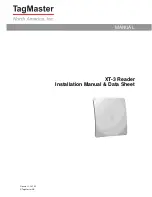
Weekly self-test of dedicated systems
BAS-APG001-EN
105
Weekly self-test of dedicated systems
(UL-864: 49.7)
Dedicated smoke-control systems shall employ a weekly automatic self-
test
(
AST). The AST automatically commands activation of each
associated function. An audible and visual trouble signal shall be
annunciated at the FSCP, identifying any function that fails to operate
within the required time period. Nondedicated smoke control systems do
not require a scheduled AST.
Dedicated smoke control system equipment must be programmed to
automatically test itself on a weekly basis. The tests ensure that the
system will operate if needed. Nondedicated smoke control system
mechanical equipment is assumed to be tested by the working HVAC
system.
Two approaches can be used to test the mechanical function of the
system: either test each damper or fan as if it is being overridden from
the smoke control panel, or test the reaction to each floor alarm. The first
technique, which is the most comprehensive and requires the least
programming, will be discussed. In either case, a failure must be
annunciated at the smoke control panel both visually and audibly. It is
acceptable to use the Trouble LED, the relevant failure LED, and the
interior audio alert.
An AST can be triggered either from a BMTX BCU or manually at the
smoke control panel. Figure 55 shows a program fragment that triggers
the AST. The scheduled trigger uses a Tracer Summit controlled binary
variable. To manually trigger the AST, the user disables the smoke
control panel and silences the audio alarms for 15 to 20 seconds. The AST
signal is then sent to the mechanical system control to start the self-test
process. Note that in the program fragment shown in Figure 55, that any
smoke alarm will disable the AST.
Figure 55. Triggering the automatic self-test (AST)
At the receiving end of the AST signal is the mechanical system which is
under test. The automatic self-test is 10 minutes long. The outputs of the
program are system fault, damper direction (Open/Close) or fan state
Содержание Engineered Smoke Control System
Страница 1: ...BAS APG001 EN Applications Guide Engineered Smoke Control System for TRACER SUMMIT ...
Страница 2: ......
Страница 3: ...BAS APG001 EN September 2006 Applications Guide Engineered Smoke Control System for TRACER SUMMIT ...
Страница 6: ......
Страница 12: ...Contents vi BAS APG001 EN ...
Страница 30: ...Chapter 1 Smoke control overview 18 BAS APG001 EN ...
Страница 48: ...Chapter 3 Installation diagrams 36 BAS APG001 EN Figure 14 Tracer MP581 to FSCS wiring ...
Страница 50: ...Chapter 3 Installation diagrams 38 BAS APG001 EN Figure 15 Tracer MP581 to FACP wiring ...
Страница 57: ...Wiring high voltage ac power BAS APG001 EN 45 Figure 19 AC wiring ...
Страница 59: ...EMI RFI considerations BAS APG001 EN 47 Figure 20 Checking the earth ground ...
Страница 75: ...EMI RFI considerations BAS APG001 EN 63 Figure 31 Checking the earth ground ...
Страница 96: ...Chapter 5 Installing the Tracer MP581 programmable controller 84 BAS APG001 EN ...
Страница 104: ...Chapter 6 Installing the EX2 expansion module 92 BAS APG001 EN Figure 49 I O bus wiring example 2 ...
Страница 110: ...Chapter 6 Installing the EX2 expansion module 98 BAS APG001 EN ...
Страница 123: ...End process verification BAS APG001 EN 111 Figure 61 ast actuator fail checkb 3 13 06 ...
Страница 132: ...Chapter 7 Programming 120 BAS APG001 EN ...
Страница 151: ...Understanding bindings BAS APG001 EN 139 Figure 79 Mixed subnet node and group bindings ...
Страница 152: ...Chapter 8 Network variable bindings 140 BAS APG001 EN ...
Страница 154: ...Appendix A References 142 BAS APG001 EN ...
Страница 155: ......
















































